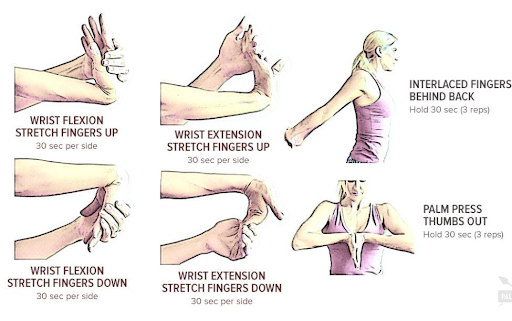Just as there are many causes of wrist pain, the symptoms of wrist pain vary widely most commonly these include –
- Tenderness of the joint
- Redness or swelling
- Pain when performing regular movements and activities
How Can I Relieve Wrist Pain?
Wrist pain assessment typically includes with your Physiotherapist:
- A conversation about any recent injuries or activities that have triggered the wrist pain
- A full assessment of the wrist structure
- A possible x-ray (depending on the mechanism of injury)
Wrist pain treatment will vary depending on the cause of your injury or condition with common wrist pain treatments include –
- Customised splinting
- Education on injury prevention and rehabilitation
- Exercises
In some cases, surgery may be indicated especially if conservative management has not been helpful
What Does Tendonitis Feel Like In The Wrist?
Tendonitis is a common problem that occurs in the wrist. How it feels greatly depends on the severity and location of the tendonitis in the wrist . Here are some of the more common things that you might feel if you have tendonitis in the wrist –
- Pain – usually a dull passive ache that is worse in the morning and with excessive movement. In more serious cases, it can be a sharp and stabbing pain or even a burning sensation. The pain can also radiate up the elbow or into the fingers
- Reduced strength with certain movements – This may be felt especially with the following movements; gripping, pinching, throwing, typing and using small objects like a computer mouse
- Stiffness in the wrist – usually worse in the morning
- Swelling – Usually at the location of the affected tendon area and can extend to the fingers and/or forearm
- Reduced ability to bear weight with the affected wrist – Push-ups, lifting objects and even getting out of bed or a chair can be painful in the affected wrist
When Should I See A Physio / Doctor For Wrist Pain?
If you are experiencing any of the mentioned symptoms above and still having pain that is not resolving with rest or symptoms that are not going away, you should see a physio or doctor.
Numerous medical interventions including physiotherapy interventions have been shown to be of great benefit for wrist pain. Rather than prolonging the injury and potentially worsening it, seeing a healthcare professional sooner can help the condition to be diagnosed, properly treated and as a result, get you back to the activities you like sooner!
What Are The Best Exercises To Help Wrist Pain?
Wrist pain is very common especially amongst people who either work in or participate in physically demanding jobs such as manual labourers or athletes (Ferguson et al ., 2019). Numerous types of exercises have shown to be of great benefit to wrist pain but is dependent on the type of injury that the wrist has sustained or ongoing condition (Menta et al., 2015). Strengthening of the forearm, shoulder and muscles around the wrist can help with wrist pain and specifically certain exercises such as isometric holds for wrist conditions like tendinopathies or tendonitis can be great pain relievers. However, prior to doing exercises, you should have your condition assessed by a relevant health care professional to see which exercises can be beneficial for your condition.
If you have just sustained a wrist sprain or strain, you should follow the RICER (rest, ice, compression, elevation and referral) protocol to help manage the pain. Ice in particular can help to reduce swelling in the wrist, if present.
The gentle stretches shown below can be beneficial to help increase range of movement and pain in the wrist if the wrist feels stiff or restricted (should be relatively pain free, stop if any produces more pain!).

How Can I Relieve Wrist Pain?
Wrist pain assessment typically includes with your Physiotherapist –
- A conversation about any recent injuries or activities that have triggered the wrist pain
- A full assessment of the wrist structure
- A possible x-ray (depending on the mechanism of injury)
Wrist pain treatment will vary depending on the cause of your injury or condition with common wrist pain treatments include –
- Customised splinting
- Education on injury prevention and rehabilitation
- Exercises
- In some cases, surgery may be indicated especially if conservative management has not been helpful
What Does Tendonitis Feel Like In The Wrist?
Tendonitis is a common problem that occurs in the wrist. How it feels greatly depends on the severity and location of the tendonitis in the wrist . Here are some of the more common things that you might feel if you have tendonitis in the wrist –
- Pain – usually a dull passive ache that is worse in the morning and with excessive movement. In more serious cases, it can be a sharp and stabbing pain or even a burning sensation. The pain can also radiate up the elbow or into the fingers
- Reduced strength with certain movements – This may be felt especially with the following movements; gripping, pinching, throwing, typing and using small objects like a computer mouse
- Stiffness in the wrist – usually worse in the morning
- Swelling – Usually at the location of the affected tendon area and can extend to the fingers and/or forearm
- Reduced ability to bear weight with the affected wrist – Push-ups, lifting objects and even getting out of bed or a chair can be painful in the affected wrist

When Should I See A Physio / Doctor For Wrist Pain?
If you are experiencing any of the mentioned symptoms above and still having pain that is not resolving with rest or symptoms that are not going away, you should see a physio or doctor.
Numerous medical interventions including physiotherapy interventions have been shown to be of great benefit for wrist pain. Rather than prolonging the injury and potentially worsening it, seeing a healthcare professional sooner can help the condition to be diagnosed, properly treated and as a result, get you back to the activities you like sooner!
What Are The Best Exercises To Help Wrist Pain?
Wrist pain is very common especially amongst people who either work in or participate in physically demanding jobs such as manual labourers or athletes (Ferguson et al ., 2019). Numerous types of exercises have shown to be of great benefit to wrist pain but is dependent on the type of injury that the wrist has sustained or ongoing condition (Menta et al., 2015). Strengthening of the forearm, shoulder and muscles around the wrist can help with wrist pain and specifically certain exercises such as isometric holds for wrist conditions like tendinopathies or tendonitis can be great pain relievers. However, prior to doing exercises, you should have your condition assessed by a relevant health care professional to see which exercises can be beneficial for your condition.
If you have just sustained a wrist sprain or strain, you should follow the RICER (rest, ice, compression, elevation and referral) protocol to help manage the pain. Ice in particular can help to reduce swelling in the wrist, if present.
The gentle stretches shown below can be beneficial to help increase range of movement and pain in the wrist if the wrist feels stiff or restricted (should be relatively pain free, stop if any produces more pain!).
What Are The Best Exercises To Help Wrist Pain?
Wrist pain is very common especially amongst people who either work in or participate in physically demanding jobs such as manual labourers or athletes (Ferguson et al ., 2019). Numerous types of exercises have shown to be of great benefit to wrist pain but is dependent on the type of injury that the wrist has sustained or ongoing condition (Menta et al., 2015). Strengthening of the forearm, shoulder and muscles around the wrist can help with wrist pain and specifically certain exercises such as isometric holds for wrist conditions like tendinopathies or tendonitis can be great pain relievers. However, prior to doing exercises, you should have your condition assessed by a relevant health care professional to see which exercises can be beneficial for your condition.
If you have just sustained a wrist sprain or strain, you should follow the RICER (rest, ice, compression, elevation and referral) protocol to help manage the pain. Ice in particular can help to reduce swelling in the wrist, if present.
The gentle stretches shown below can be beneficial to help increase range of movement and pain in the wrist if the wrist feels stiff or restricted (should be relatively pain free, stop if any produces more pain!).
What Are The Best Exercises To Help Wrist Pain?
Wrist pain is very common especially amongst people who either work in or participate in physically demanding jobs such as manual labourers or athletes (Ferguson et al ., 2019). Numerous types of exercises have shown to be of great benefit to wrist pain but is dependent on the type of injury that the wrist has sustained or ongoing condition (Menta et al., 2015). Strengthening of the forearm, shoulder and muscles around the wrist can help with wrist pain and specifically certain exercises such as isometric holds for wrist conditions like tendinopathies or tendonitis can be great pain relievers. However, prior to doing exercises, you should have your condition assessed by a relevant health care professional to see which exercises can be beneficial for your condition.
If you have just sustained a wrist sprain or strain, you should follow the RICER (rest, ice, compression, elevation and referral) protocol to help manage the pain. Ice in particular can help to reduce swelling in the wrist, if present.
The gentle stretches shown below can be beneficial to help increase range of movement and pain in the wrist if the wrist feels stiff or restricted (should be relatively pain free, stop if any produces more pain!).
Again, prior to doing any stretches or exercises for wrist pain, it is best to consult a healthcare professional as exercise or stretches done incorrectly for the wrong amount of sets or repetitions can exacerbate the condition and/or increase the risk of the condition taking longer to heal.

